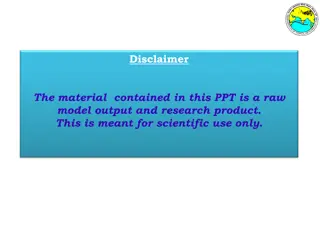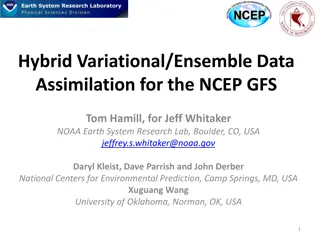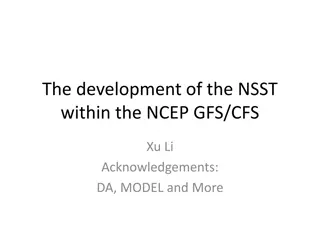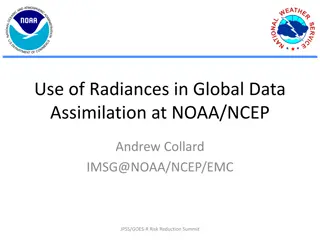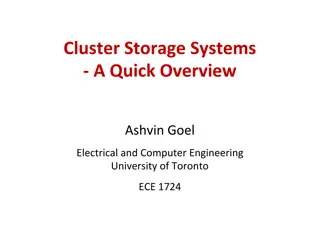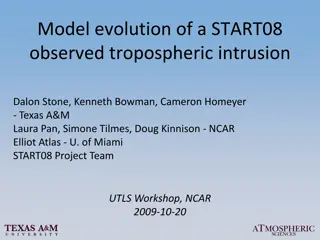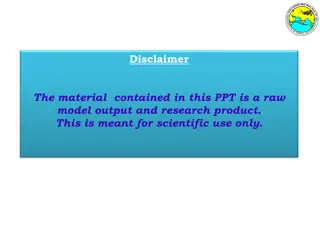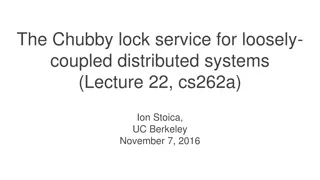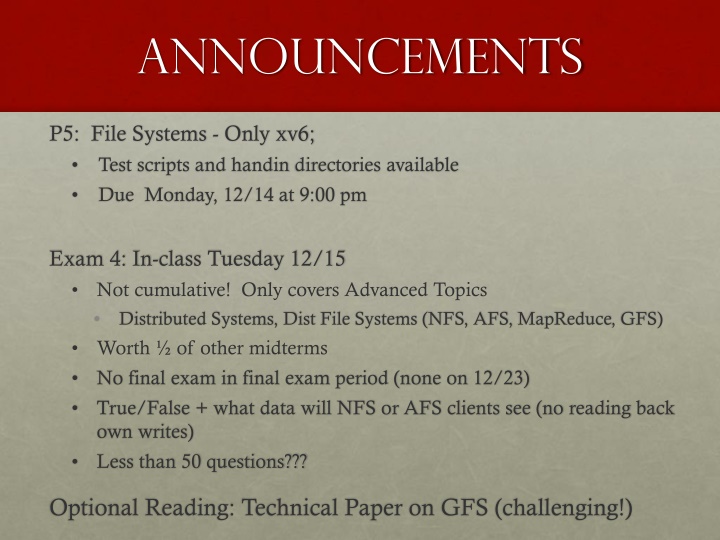
Exploring Advanced File Systems in Operating Systems
This announcement covers the availability of test scripts and hand-in directories for the xv6 file system, as well as details about Exam 4 focusing on Advanced Topics in Distributed Systems like NFS, AFS, MapReduce, and GFS. The lecture delves into the Google File System (GFS), discussing its requirements, scaling techniques, master vs. chunkservers roles, fault tolerance mechanisms, and replica consistency. It contrasts GFS with NFS, highlighting GFS's solutions for scalability and handling failures. Additionally, it introduces Hadoop Distributed FS (HDFS) as an open-source implementation evolving from GFS, and explores the opportunity for co-design in building file systems and applications together.
Download Presentation

Please find below an Image/Link to download the presentation.
The content on the website is provided AS IS for your information and personal use only. It may not be sold, licensed, or shared on other websites without obtaining consent from the author. If you encounter any issues during the download, it is possible that the publisher has removed the file from their server.
You are allowed to download the files provided on this website for personal or commercial use, subject to the condition that they are used lawfully. All files are the property of their respective owners.
The content on the website is provided AS IS for your information and personal use only. It may not be sold, licensed, or shared on other websites without obtaining consent from the author.
E N D
Presentation Transcript
Announcements P5: File Systems - Only xv6; Test scripts and handin directories available Due Monday, 12/14 at 9:00 pm Exam 4: In-class Tuesday 12/15 Not cumulative! Only covers Advanced Topics Distributed Systems, Dist File Systems (NFS, AFS, MapReduce, GFS) Worth of other midterms No final exam in final exam period (none on 12/23) True/False + what data will NFS or AFS clients see (no reading back own writes) Less than 50 questions??? Optional Reading: Technical Paper on GFS (challenging!)
UNIVERSITY of WISCONSIN-MADISON Computer Sciences Department CS 537 Introduction to Operating Systems Andrea C. Arpaci-Dusseau Remzi H. Arpaci-Dusseau Advanced Topics: Google File System (GFS) Questions answered in this lecture: What are the requirements for GFS? What techniques does GFS use to scale? What is the role of the master vs. chunkservers in GFS? What happens if the master or a chunkserver crashes? How are replicas kept consistent?
GFS Motivation Measure then build Google workload characteristics huge files (GBs); usually read in their entirety almost all writes are appends concurrent appends common high throughput is valuable low latency is not Computing environment: 1000s of machines Machines sometimes fail (both permanently and temporarily)
Why not use NFS? 1. Scalability : Must store > 100s of Terabytes of file data NFS only exports a local FS on one machine to other clients GFS solution: store data on many server machines 2. Failures: Must handle temporary and permanent failures NFS only recovers from temporary failure - not permanent disk/server failure - recovery means making reboot invisible - technique: retry (stateless and idempotent protocol helps) GFS solution: replication and failover (like RAID)
New File System: GFS Google published details in 2003 Has evolved since then Open source implementation: Hadoop Distributed FS (HDFS)
Opportunity for Co-design Do not need general-purpose file system Does not need to be backwards-compatible with existing applications Does not need to adhere to POSIX specification Opportunity to build FS and application together Make sure applications can deal with FS quirks Avoid difficult FS features: Read directory (make new directory structure) Links Reading from an open, deleted file
What Workloads? MapReduce (previous lecture) read entire input file (in chunks) compute over data append to separate output files Producer/consumer many producers append work to shared file concurrently one consumer reads and does work and appends to output file How to handle that appends are not idempotent? Require applications to handle duplicate records in data Add unique identifiers to records
GFS Overview Motivation Architecture Master metadata Chunkserver data
Machines FAIL Fact: Machines storing data may fail Implications for GFS Must replicate data (similar to RAID) Must recover (respond to machines stopping at starting)
1) Replication Server 2 Server 3 Server 1 Server 4 Server 5 BC A A A C C B B Each server holds chunks of data Less structured than RAID (no static computation to determine locations) - machines come and go - capacity may vary - different data may have different replication levels (e.g., 3 vs 5 copies) Problem: How to map logical to physical locations?
2) Recovery Server 2 Server 3 Server 1 Server 4 Server 5 BC A A A C C B B
2) Recovery Server 2 Server 3 Server 1 ??? Server 5 BC A A A A B C C B B Machine may come back, or may be dead forever Must identify and replicate lost data on other servers
2) Recovery Server 2 Server 3 Server 1 Server 4 Server 5 BC A A AB A B C C B Machine may come back; disk space wasted with extra replicas
2) Recovery Server 2 Server 3 Server 1 Server 4 Server 5 A A AB A BC B C C B Identify number of replicas and choose to remove extras
2) Recovery Server 2 Server 3 Server 1 Server 4 Server 5 BC A AB A B B C C Identify number of replicas and choose to remove extras
Observation Server 2 Server 3 Server 1 Server 4 Server 5 BC A A A B B C C Finding copies of data + maintaining replicas is difficult without global view of data
GFS Architecture Master metadata consistency easy [metadata] (one) Chunk Servers [data] local FS s Clients [workload] (many) No caching! (many) large capacity
What is a Chunk? Break GFS files into large chunks (e.g., 64MB); unit of replication; chunks not split across chunkservers Why this size? Match chunk size to input size for each mapper in MapReduce Chunk servers store physical chunks in Linux files Master maps logical chunk to physical chunk locations Server 1 Server 2 Server 3 Server 4 Server 5 BC A A A B B C C
GFS Overview Motivation Architecture Master metadata Chunkserver data
Master Metadata Master client Worker w2 chunk map: Local FS /chunks/924 => data1 /churks/521 => data2 lookup 924 logical 924 521 phys w2,w5,w7 w2,w9,w11 Client wants to read a chunk (identified with unique id num) How does it find where that chunk lives?
Client Reads a Chunk Master client Worker w2 chunk map: Local FS /chunks/924 => data1 /churks/521 => data2 w2,w5,w7 logical 924 521 phys w2,w5,w7 w2,w9,w11 Client can read from any of the listed replicas
Client Reads a Chunk Master client Worker w2 chunk map: Local FS /chunks/924 => data1 /churks/521 => data2 read 942: offset=0 size=1MB logical 924 521 phys w2,w5,w7 w2,w9,w11
Client Reads a Chunk Master client Worker w2 chunk map: Local FS /chunks/924 => data1 /churks/521 => data2 data logical 924 521 phys w2,w5,w7 w2,w9,w11
Client Reads a Chunk Master client Worker w2 chunk map: Local FS /chunks/924 => data1 /churks/521 => data2 read 942: offset=1MB size=1MB logical 924 521 phys w2,w5,w7 w2,w9,w11 Client tracks current offset of read within each 64MB chunk
Client Reads a Chunk Master client Worker w2 chunk map: Local FS /chunks/924 => data1 /churks/521 => data2 data logical 924 521 phys w2,w5,w7 w2,w9,w11
Client Reads a Chunk Master client Worker w2 chunk map: Local FS /chunks/942 => data1 /churks/521 => data2 read 942: offset=2MB size=1MB logical 924 521 phys w2,w5,w7 w2,w9,w11
Client Reads a Chunk Master client Worker w2 chunk map: Local FS /chunks/924 => data1 /churks/521 => data2 data logical 924 521 phys w2,w5,w7 w2,w9,w11
Client Reads a Chunk Master client Worker w2 chunk map: Local FS /chunks/924 => data1 /churks/521 => data2 logical 924 521 phys w2,w5,w7 w2,w9,w11 Master is not bottleneck because not involved in most reads 1 master can handle many clients How does client know what chunk id num to read?
File Namespace Master file namespace: /foo/bar => 924,813 /var/log => 123,999 client Worker w2 Local FS /chunks/924 => data1 /churks/521 => data2 lookup /foo/bar chunk map: logical 924 phys w2,w5,w7 Master maps path name to logical chunk list (expect many chunks per file) 1. Client sends path name to master 2. Master sends chunk locations to client 3. Client reads/writes to workers directly
File Namespace Master file namespace: /foo/bar => 924,813 /var/log => 123,999 client Worker w2 Local FS /chunks/924 => data1 /churks/521 => data2 924: [w2,w5,w7] 813: [ ] chunk map: logical 924 phys w2,w5,w7 Master maps path name to logical chunk list 1. Client sends path name to master 2. Master sends chunk locations to client 3. Client reads/writes to workers directly
File Namespace Master file namespace: /foo/bar => 924,813 /var/log => 123,999 client Worker w2 Local FS /chunks/924 => data1 /churks/521 => data2 read 924: offset=0MB size=1MB chunk map: logical 924 phys w2,w5,w7
How to pick Chunk Size? GFS uses large chunks, e.g., 64MB (coordinate with MapReduce) How does chunk size affect size of master data structs? What if Chunk Size Doubles? Any disadvantages to making chunks huge? Cannot parallelize I/O as much Master file namespace: /foo/bar => 924,813 /var/log => 123,999 lists half as long chunk map: logical 924 813 phys half as many entries w2,w5,w7 w1,w8,w9
Master: Crashes + Consistency Advantage to minimizing master data structures: Master file namespace: /foo/bar => 924,813 /var/log => 123,999 File namespace and chunk map fit 100% in RAM Advantage? Fast (Allows master to keep up with 1000 s of workers) Disadvantage? Limits size of namespace to what fits in RAM What if master crashes? chunk map: logical 924 813
How to Handle Master crashing Master file namespace: /foo/bar => 924,813 /var/log => 123,999 Two data structures to worry about How to make namespace persistent? Write updates to namespace to multiple logs chunk map: logical 924 813 Where should these logs be located? Local disk (disk is never read except for crash) Disks on backup masters Shadow read-only masters (may lag state, temporary access) Result: High availability when master crashes! What about chunk map?
Chunk Map Consistency Don t persist chunk map on master Approach: After crash (and periodically for cleanup), master asks each chunkserver which chunks it has What if chunk server dies too? Doesn t matter, that worker can t serve chunks anyway Master Worker I have {A,B,C,D} A B C D What if one of chunk server s disks dies?
GFS Overview Motivation Architecture Master metadata Chunkserver data
Chunkserver Consistency How does GFS ensure physical chunks on different chunkservers are consistent with one another? Corruption: delete chunks that violate checksum Master eventually sees chunk has < desired replication What about concurrent writes (or appends) from different clients? (e.g., multiple producers) Server 1 Server 2 Server 3 Server 4 Server 5 BC A A A B B C C
chunk 143 (replica 1) chunk 143 (replica 2) chunk 143 (replica 3) AAAA AAAA AAAA AAAA AAAA AAAA AAAA AAAA AAAA
chunk 143 (replica 1) chunk 143 (replica 2) chunk 143 (replica 3) AAAA AAAA AAAA AAAA AAAA AAAA AAAA AAAA AAAA write BBBB write CCCC
chunk 143 (replica 1) chunk 143 (replica 2) chunk 143 (replica 3) AAAA BBBB AAAA AAAA AAAA AAAA AAAA AAAA AAAA write BBBB write CCCC
chunk 143 (replica 1) chunk 143 (replica 2) chunk 143 (replica 3) AAAA BBBB AAAA AAAA AAAA AAAA AAAA CCCC AAAA write BBBB write CCCC
chunk 143 (replica 1) chunk 143 (replica 2) chunk 143 (replica 3) AAAA BBBB AAAA AAAA BBBB AAAA AAAA CCCC AAAA write BBBB write CCCC
chunk 143 (replica 1) chunk 143 (replica 2) chunk 143 (replica 3) AAAA BBBB AAAA AAAA CCCC AAAA AAAA CCCC AAAA write BBBB write CCCC
chunk 143 (replica 1) chunk 143 (replica 2) chunk 143 (replica 3) AAAA BBBB AAAA AAAA CCCC AAAA AAAA BBBB AAAA write BBBB write CCCC
chunk 143 (replica 1) chunk 143 (replica 2) chunk 143 (replica 3) AAAA CCCC AAAA AAAA CCCC AAAA AAAA BBBB AAAA write BBBB write CCCC
chunk 143 (replica 1) chunk 143 (replica 2) chunk 143 (replica 3) AAAA CCCC AAAA AAAA CCCC AAAA AAAA BBBB AAAA
chunk 143 (replica 1) chunk 143 (replica 2) chunk 143 (replica 3) AAAA CCCC AAAA AAAA CCCC AAAA AAAA BBBB AAAA Chunks disagree, but all checksums are correct, all writes suceeeded, and no machines ever failed!! Ideas?
Chunkserver Consistency GFS must serialize writes across chunkservers Decide an order of writes and ensure order is followed by every chunkserver How to decide on an order? don t want to overload master let one replica be primary and decide order of writes from clients
Steps of GFS write Primary: assign seq num to each write Performance Optimization: Data flows w/ most efficient network path Correctness: Control flow ensures data committed in same order
Primary Replica Master chooses primary replica for each logical chunk What if primary dies? Give primary replica a lease that expires after 1 minute If master wants to reassign primary, and it can t reach old primary, just wait 1 minute


